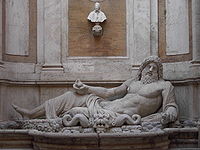- Marforio
-
A Talking Statue of Rome Marphurius
MarforioInformation Original subject Oceanus Name origin Corruption of Latin mare in foro, "the sea in the forum" (inscribed near the statue's original location) Creation 1st century AD Location Palazzo Nuovo
41°53′34.38″N 12°28′57.33″E / 41.8928833°N 12.4825917°EMarphurius[1][2][3] or Marforio (Italian: Marforio; Medieval Latin: Marphurius, Marforius) is one of the talking statues of Rome. Marforio maintained a friendly rivalry with his most prominent rival, Pasquin. As at the other five "talking statues", pasquinades — irreverent satires poking fun at public figures — were posted beside Marforio in the 16th and 17th centuries.
Marforio is a large 1st century Roman marble sculpture of a reclining bearded river god or Oceanus,[4] which in the past has been variously identified as a depiction of Jupiter, Neptune, or the Tiber. It was the humanist and antiquarian Andrea Fulvio who first identified it as a river god, in 1527.[5] The Marfoi was a landmark in Rome from the late 12th century.[6] Poggio Bracciolini wrote of it as one of the sculptures surviving from Antiquity,[7] and in the early 16th century it was still near the Arch of Septimius Severus, where the various authors reported it.[8]
The origin of its name is a matter of some debate. It was discovered with a granite basin bearing the inscription "mare in foro",[9] but may take its name from the Latin name for the area in which it was discovered (Martis Forum), or from the Marioli (or Marfuoli) family who owned property near the Mamertine Prison, also near the forum, where the statue was sited until 1588.
Pope Sixtus V had the statue moved to the piazza di San Marco in 1588, and then to the piazza del Campidoglio in 1592, where it decorates a fountain designed by Giacomo Della Porta on a wall of the Basilica di Santa Maria in Ara Coeli, facing the Palazzo dei Conservatori. In 1645, the building of the Palazzo Nuovo enclosed the fountain. Part of the face, the right foot, and the left hand holding a shell were restored in 1594. The statue was moved again in the 17th century, at the order of Pope Innocent X, who had it placed in the courtyard of the Palazzo dei Conservatori, where it remains today.
Contents
See also
- The Scior Carera in Milan.
Notes
- ^ The Encyclopedia Britannic: Vol. XVIII. New York: Henry G. Allen and Co. 1888. http://books.google.com/books?id=GKMMAAAAYAAJ&printsec=titlepage.
- ^ Jourdain, Eleanor F. (1921). Dramatic Theory and Practice in France. London: Longmans, Green, and Co. http://books.google.com/books?id=qVVcAAAAMAAJ&printsec=titlepage.
- ^ von Hofmannsthal, Hugo (1975). Sämtichle Werke. S. Fischer. http://books.google.com/books?lr=&id=XvKyAAAAIAAJ&dq=marphurius+marforio&q=&pgis=1.
- ^ The restoration of his right hand, grasping a shell, was inspired by, and supported, the identification as Oceanus.
- ^ Fulvio, Antiquitatis Urbis 1527, noted by Francis Haskell and Nicholas Penny, Taste and the Antique: The Lure of Classical Sculpture 1500-1900 (Yale University Press) 1981:259.
- ^ Roberto Valentini and Giuseppe Zucchetti, Codice topographa della Città di Roma (1940-53) vol. III: p. 226.
- ^ Bracciolini, De varietate fortunae, written over a long period, ca 1430 to 1445.
- ^ Haskell and Penny 1981:258.
- ^ The black and white granite basin was shifted to form a fountain for watering cattle in the Campo Vaccino, as the Roman Forum had become; it was removed in 1818 to stand before one of the Horse Tamers on the Quirinal Hill, often known in the past as Alexander and Bucephalus (Haskell and Penny 1981:136, 258.
Bibliography
- Rendina, C., "Pasquino statua parlante”, ROMA ieri, oggi, domani, n. 20, February 1990.
External links
- Roma Segreta: Marforio (Italian)
- Marforio
- The Insider's Guide to Rome, p.73
- Chambers' Edinburgh Journal, p.106
- Marforio
Categories:
Wikimedia Foundation. 2010.

